The Late Ordovician: 1
The Late Ordovician Epoch of the Ordovician Period: 461 to 444 million years ago
As we have mentioned, the ICS has an unreasonable prejudice against savage Celts. The Ordovician ages historically bore the proud names of ferocious Welsh tribes. But sadly, under the ICS system, the base of the Late Ordovician is the "Sandbian," with its global type section at (God help us!) Fågelsång, which means "bird song" or something equally insipid. To make matters worse, the letter 'å' -- so far as we are aware -- exists only in Swedish. The Swedes are inordinately proud of the fact that none but a Swede can make this particular noise. We are forced to take this on faith, since all 18 possible vowels in Swedish sound exactly the same to most listeners. We have even toyed with the idea that the supposed differences are audible only at hypersonic frequencies, and that all Swedes in fact possess a unique form of echolocation. Fortunately, however, this page is about the Late Ordovician. Thus it will not be necessary for us to entertain this disturbing conjecture at any greater length.
The Caledonian Orogeny
 We might imagine Ordovician paleogeography as some vast Las Vegas stage, with appreciative crowds (represented by Baltica and Laurentia) applauding chorus lines of smiling, bespangled terranes as they break off from the background of the north Gondwanan margin, kicking and twirling their way across the southern ocean to the steps of some complex, but orderly, tectonic choreography.
We might imagine Ordovician paleogeography as some vast Las Vegas stage, with appreciative crowds (represented by Baltica and Laurentia) applauding chorus lines of smiling, bespangled terranes as they break off from the background of the north Gondwanan margin, kicking and twirling their way across the southern ocean to the steps of some complex, but orderly, tectonic choreography.
Then again, we might not wish to imagine anything of the sort, since we would then be forced to visualize the first few rows of the audience being violently subducted under the inexorably advancing chorus line, the roar of the crowd being swallowed in the volcanic explosions of the Caledonian Orogeny, followed by the howling gale of an Ice Age and mass extinction. This would be ambitious, even for Las Vegas -- more Götterdämmerung than glitz.
The grand collision at the end of the Ordovician occurred in several parts. First was the meeting of Baltica and Avalonia, a chain of terranes which had rifted off the Gondwanan coast early in the Ordovician. The line of islands moved generally northwest, leaving the expanding Rheic Ocean behind it and closing the Iapetus Ocean as it neared the Laurentian margin.
By this epoch, Baltica had slowed its own drive to the north, although it was still gradually crossing the equator. Nawrocki & Poprawa (2006). As Avalonia began to close the Iapetus, its northeastern end also met the western edge of Baltica, closing the Tornquist Ocean. This initiated the Caledonian Orogeny in the north of England. Cocks & Torsvik 2005).
Second, the northern arm of the Iapetus, between Baltica and Laurentia, closed at the endof the Late Ordovician. This triggered an extension of the Acadaian Orogeny into both Baltica and (to a certain extent) Laurentia. The northern portions of Poland, Denmark, and Germany began to form at this time. Nawrocki & Poprawa (2006).
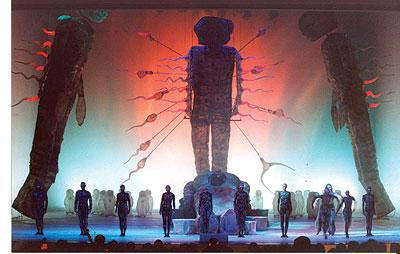 The Avalonian collision was the second of (about) three such events to affect Laurentia and Baltica over the course of the Middle Paleozoic. Stanley (1998). The collision between western Avalonia and Laurentia, and the addition of more Gondwanan blocks, would prolong the Caledonian events into the Early Devonian.
The Avalonian collision was the second of (about) three such events to affect Laurentia and Baltica over the course of the Middle Paleozoic. Stanley (1998). The collision between western Avalonia and Laurentia, and the addition of more Gondwanan blocks, would prolong the Caledonian events into the Early Devonian.
Some of these non-Avalonian fragments, which comprise a significant part of today's Europe, also began to rift from the coast of Gondwana (particularly Africa) during the Late Ordovician. The sequence and timing of these events is less clear than it once was. The original story was that Avalonia was succeeded by Armorica, a second island arc that left Gondwana and more or less followed Avalonia's path across the waves to Baltica and Laurentia. Armorica was said to include parts of Spain, the Massif Central and Brittany of France, the Saxo-Thuringian Plate of Germany, Bohemia (Perunica), Bosnia, and other indispensible components of the European Union. But, in the last few years, geologists have begun to chip pieces off Armorica (Nysæther et al., 2002; Torsvik & Cocks, 2004), or split it into two separate arcs (Nysæther et al., 2002). In fact, the tendency now is to discard the whole idea of Armorica as unit and refer to it vaguely as the "Armorican Terrane Assemblage" (Cocks & Torsvik, 2005).
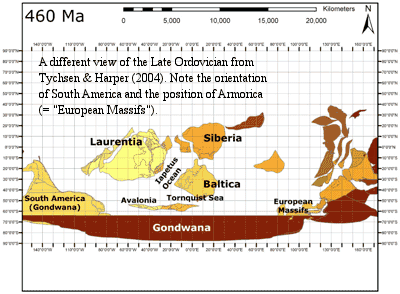 Somewhere to the south of Laurentia was the South American coast of Gondwana. The intervening ocean may have been narrow. Some geologists (e.g. Ian Dalziel) have argued for actual contact between Laurentia and South America in the earlier Ordovician. However, by the Late Ordovician, several pieces of Mexico and Florida probably covered the northern coast of South America (Ortega-Obregón et al., 2008), which was formed by Peru during this epoch.
Somewhere to the south of Laurentia was the South American coast of Gondwana. The intervening ocean may have been narrow. Some geologists (e.g. Ian Dalziel) have argued for actual contact between Laurentia and South America in the earlier Ordovician. However, by the Late Ordovician, several pieces of Mexico and Florida probably covered the northern coast of South America (Ortega-Obregón et al., 2008), which was formed by Peru during this epoch.
We will defer further discussion of West Gondwana (South America and Africa) until we can take on the Hirnantian Ice Age in general. In fact, we will slide over the rest of the world very quickly, as we've already spent too much of our own, personal time and space on the events in the Laurussian theater.
As in earlier parts of the Ordovician, West Gondwana sat over the South Pole, with the Pole itself wandering nomadically in what is now the Sahara. The rest of Gondwana extended like a sort of gigantic tail northwards from the West Gondwanan head, terminating in the North China craton, which reached north of the equator. This tail remained more or less on the opposite side of the earth from Baltica and Laurentia. North and west of the East Gondwanan tail, some of the Asian blocks were forming. In particular, Siberia was beginning to pick up and consolidate a number of unaffiliated blocks, as discussed in a recent review by Cocks & Torsvik 2007). ATW080321.
The End-Ordovician Ice Age
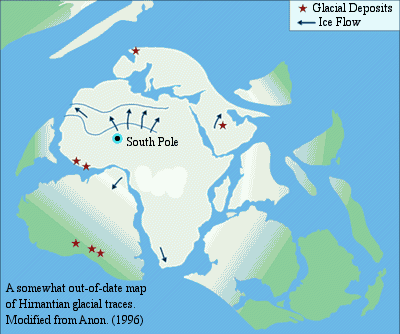 For the most part, the Late Ordovician climate was like the Middle Ordovician climate, but more so. The world continued warm, with two episodes of global warming in the early and middle or late Hirnantian. Cocks & Torsvik 2005). The seas continued to rise. Stanley (1998). All this, as we will see, was good for life. But it ended, quite suddenly Webby, 2004) with a brief ice age at the end of the Hirnantian.
For the most part, the Late Ordovician climate was like the Middle Ordovician climate, but more so. The world continued warm, with two episodes of global warming in the early and middle or late Hirnantian. Cocks & Torsvik 2005). The seas continued to rise. Stanley (1998). All this, as we will see, was good for life. But it ended, quite suddenly Webby, 2004) with a brief ice age at the end of the Hirnantian.
This particular ice age seems to have been quite different from those of the Proterozoic or Pleistocene. It was perhaps similar to the ice age(s) of the Mississippian, but considerably shorter. On the evidence of oxygen isotope excursions, the end-Ordovician event lasted only about 500,000 years. Stanley (1998). Even so, it seems to have included several distinct periods of glaciation. It is unclear exactly how many glacial events there were. Depending on location, there may have been only one, or as many as five.
These are minimum figures, based on the number of successive layers of glacial till. It is entirely possible that, in any given location, a late glacial event might destroy all evidence of earlier events. Yet there's bit of a pattern. Ghienne et al. (2007) find two cycles in Algeria. Le Heron et al. (2006) located four in Libya. Connally & Wiltse (1996) describe five in Saudi Arabia. This suggests that the south polar region retained a permanent ice cap, which expanded east or contracted west, depending on the severity of the various glacials and interglacials. Unfortunately, we must also entertain the possibility that the events may, instead, have been localized and asynchronous, since one of the Saudi events has been ascribed to the Rhuddanian (earliest Llandovery).
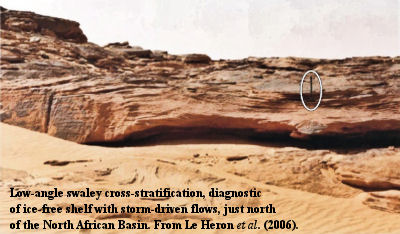 Perhaps more interesting is the nature and movement of the ice sheets. In the map from Connally and Wiltse, note how the main flow is directed into a North African basin, not off the nearest edge of the continental platform. This is confirmed by the studies cited above. In addition the ice flow was highly heterogeneous. That is, it included numerous ice rivers which moved quite quickly while adjacent ice remained almost stationary. The bases of the ice sheets show considerable evidence of subglacial melting and substantial flows of meltwater undercutting the ice.
Perhaps more interesting is the nature and movement of the ice sheets. In the map from Connally and Wiltse, note how the main flow is directed into a North African basin, not off the nearest edge of the continental platform. This is confirmed by the studies cited above. In addition the ice flow was highly heterogeneous. That is, it included numerous ice rivers which moved quite quickly while adjacent ice remained almost stationary. The bases of the ice sheets show considerable evidence of subglacial melting and substantial flows of meltwater undercutting the ice.
Two other data are interesting. First, Le Heron et al. (2006) emphasize the local importance of a glacial trampoline effect: subsidence caused by the weight of the ice sheet, followed by post-glacial rebound. This is peculiar for a short-lived ice sheet which ought not to have been particularly thick. Second, Ghienne et al. 2007) argue that, contrary to conventional wisdom (e.g. Benton & Harper, 1997; Stanley, 1998), the Hirnantian ice age occurred during a time of rising sea levels. They assert that the maximum intrusion of marine conditions into the interior of Africa (as judged by the presence of graptolites and other marine forms) did not occur until the earliest Silurian.
As you have probably guessed, we have not presented these particular facts merely for the general edification of the reader, but rather to introduce yet another futile and unsubstantiated speculation on a subject we are grossly unqualified to address: to wit, the cause of the Hirnantian ice age. But that is the trade-off at the heart of Palaeos. The reader obtains the questionable benefit of our research into the facts, while we are permitted to imagine that someone may imbibe the facile concoctions we brew to make sense of the data.
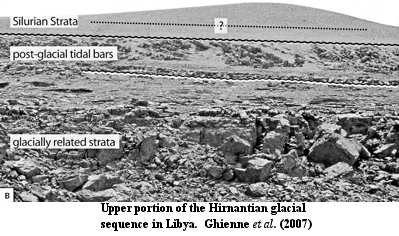 Our thought is that the Hirnantian ice required only a deep south polar basin and a rising sea. Without question, the oceans gradually transgressed over northern Africa over the course of the Ordovician. At some point, the seas filled the North African Basin. However, contact with the ocean was initially limited and irregular. It may well have been limited to occasional storms, since tempestites and other indicators suggest that the area to the north of the basin was (during the earliest phase of glaciation) "an open shelf that was free of sea ice ... and that was subject to episodic, very high-energy storms." Le Heron et al. (2006).
Our thought is that the Hirnantian ice required only a deep south polar basin and a rising sea. Without question, the oceans gradually transgressed over northern Africa over the course of the Ordovician. At some point, the seas filled the North African Basin. However, contact with the ocean was initially limited and irregular. It may well have been limited to occasional storms, since tempestites and other indicators suggest that the area to the north of the basin was (during the earliest phase of glaciation) "an open shelf that was free of sea ice ... and that was subject to episodic, very high-energy storms." Le Heron et al. (2006).
Since contact with open water was limited, the basin filled with a large volume which was thermally isolated from the oceans and located at or near the South Pole. Consequently, it froze. When it had frozen through, the weight of the ice locally depressed the basin further, accommodating more water. At this point, the coldest regions episodically become cold enough to accumulate "real" ice sheets through precipitation. Given the geography of the area, we would expect to see this ice forming near the Pole and flowing generally eastward (paleo-northeast) from Algeria into Libya and Arabia. This should occur, both because the coldest regions would lie westward and because the west end was in closest contact with the ocean. The west (Algeria) would thus be permanently frozen, while locations to the east would show an increasing number of episodic glacial "events."
At the same time, the ocean would continue to contribute water, which would melt and undermine the basin ice, perhaps causing the complex pattern of ice flow and subglacial melting actually observed. Over the slightly longer run, the rising seas outpaced the growth of the ice sheet and established regular contact with the north African basin. This ended the thermal isolation of the South Polar region. At this point, the ice cap would melt quickly. Isostatic rebound of the crust would briefly displace water, which, together with generally rising sea levels, briefly flooded additional areas post-glaciation, as observed by Ghienne et al. 2007). But the era of rising seas was now over, and the ocean began to retreat from the Sahara early in the Silurian. ATW080322.
page uploaded 5 June 2002
last modified ATW080322
checked ATW031222
 We might imagine Ordovician paleogeography as some vast Las Vegas stage, with appreciative crowds (represented by Baltica and Laurentia) applauding chorus lines of smiling, bespangled terranes as they break off from the background of the north Gondwanan margin, kicking and twirling their way across the southern ocean to the steps of some complex, but orderly, tectonic choreography.
We might imagine Ordovician paleogeography as some vast Las Vegas stage, with appreciative crowds (represented by Baltica and Laurentia) applauding chorus lines of smiling, bespangled terranes as they break off from the background of the north Gondwanan margin, kicking and twirling their way across the southern ocean to the steps of some complex, but orderly, tectonic choreography. The Avalonian collision was the second of (about) three such events to affect Laurentia and Baltica over the course of the Middle Paleozoic.
The Avalonian collision was the second of (about) three such events to affect Laurentia and Baltica over the course of the Middle Paleozoic. 


